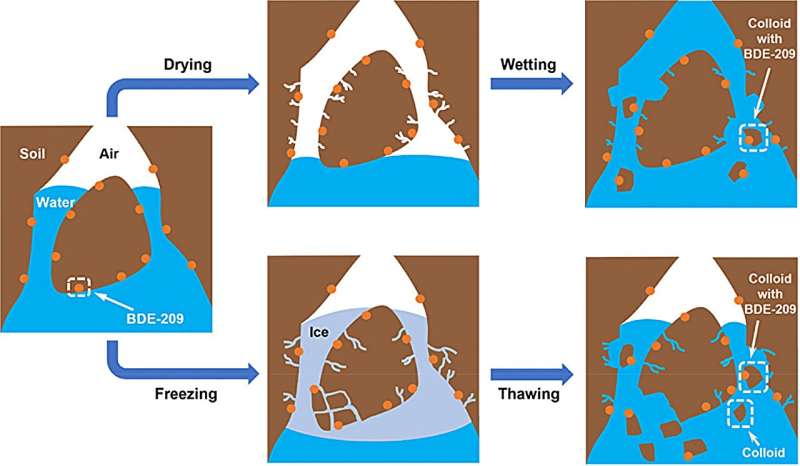This article has been reviewed according to Science X's editorial process and policies. Editors have highlighted the following attributes while ensuring the content's credibility:
fact-checked
proofread
Decoding contaminant mobility: Transient flows and e-waste pollution dynamics

Changing weather patterns, like dry-wet and freeze-thaw cycles, significantly impact the release of harmful chemicals known as polybrominated diphenyl ethers (PBDEs) from soils at e-waste recycling sites. Tiny soil particles, called colloids, play a crucial role in moving these pollutants. New research from Nankai University emphasizes the need to consider these natural cycles when assessing environmental risks and managing contamination, offering new insights into controlling the spread of PBDEs in polluted areas.
Polybrominated diphenyl ethers (PBDEs) are persistent organic pollutants commonly found in e-waste recycling sites, posing severe environmental risks due to their toxicity and persistence. Previous studies have identified colloid-facilitated transport as a key mechanism in the subsurface migration of these contaminants. However, the influence of transient flow conditions on this process remains poorly understood. Based on these challenges, it is crucial to conduct in-depth research on the effects of these conditions on PBDE mobility.
The researchers from Nankai University published a study in Eco-Environment & Health examining how dry-wet and freeze-thaw cycles affect the release of BDE-209 from soil at an e-waste site in Taizhou, China. The study employed undisturbed soil core leaching tests to simulate these transient flow conditions, providing new insights into the behavior of PBDEs in contaminated environments.
The study revealed that both dry-wet and freeze-thaw cycles significantly influence the release of BDE-209 from soil, with colloids playing a crucial role in this process. During dry-wet cycles, the drying period induced differential capillary stress, promoting colloid generation through soil pore wall cracking. This led to higher concentrations of BDE-209 in the colloids compared to those from freeze-thaw cycles.
Conversely, freeze-thaw cycles caused mechanical stress from water expansion and contraction, resulting in the formation of inorganic colloidal particles with lower BDE-209 content.
The researchers found that the drying duration and intensity of the cycles directly affected the amount and type of colloids mobilized, thereby impacting the concentration of BDE-209 in the leachate. These findings emphasize the importance of considering transient flow conditions in assessing the environmental risks of PBDEs at contaminated sites.
Dr. Chuanjia Jiang, the lead author, stated, "Our findings underscore the critical role of transient flow conditions in the mobility of hydrophobic contaminants like BDE-209. Understanding these mechanisms is essential for developing effective strategies to mitigate the spread of such pollutants in the environment, especially in areas impacted by e-waste recycling activities."
This research provides valuable insights for environmental scientists and policymakers working on contamination management at e-waste sites. By highlighting the effects of transient flow conditions on PBDE release, the study suggests that hydrological intervention measures, such as controlled drying and freeze-thaw management, could be developed to limit the mobilization and spread of these harmful contaminants, ultimately protecting groundwater quality and reducing human exposure risks.
More information: Yueyue Li et al, Effects of transient flow conditions on colloid-facilitated release of decabromodiphenyl ether: Implications for contaminant mobility at e-waste recycling sites, Eco-Environment & Health (2024). DOI: 10.1016/j.eehl.2024.03.002
Provided by Nankai University



















